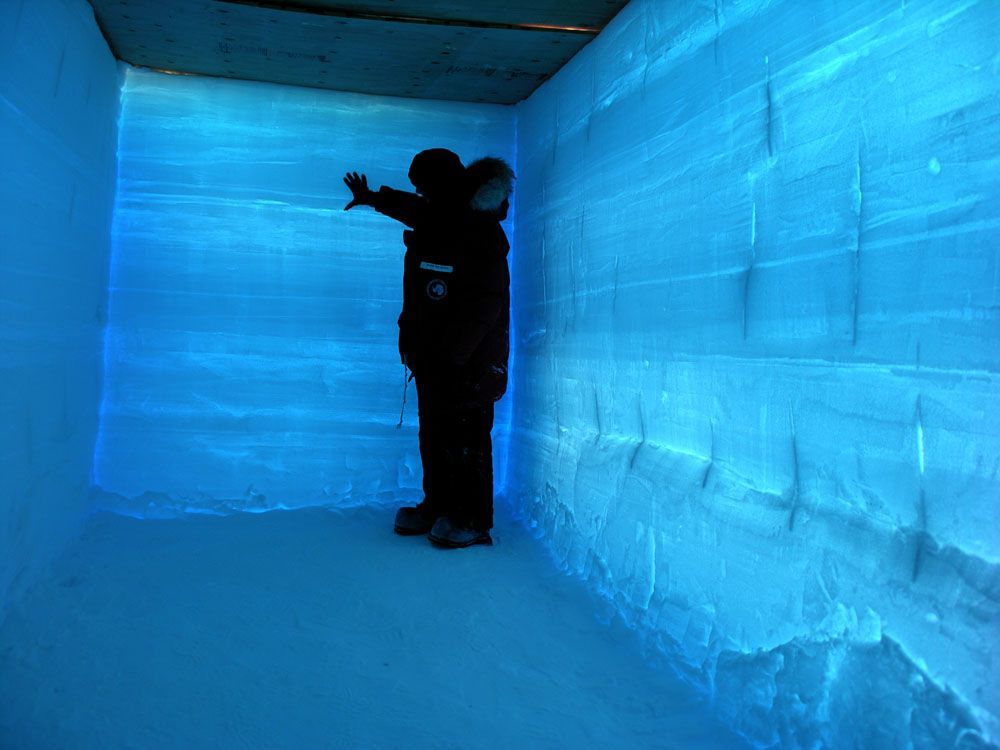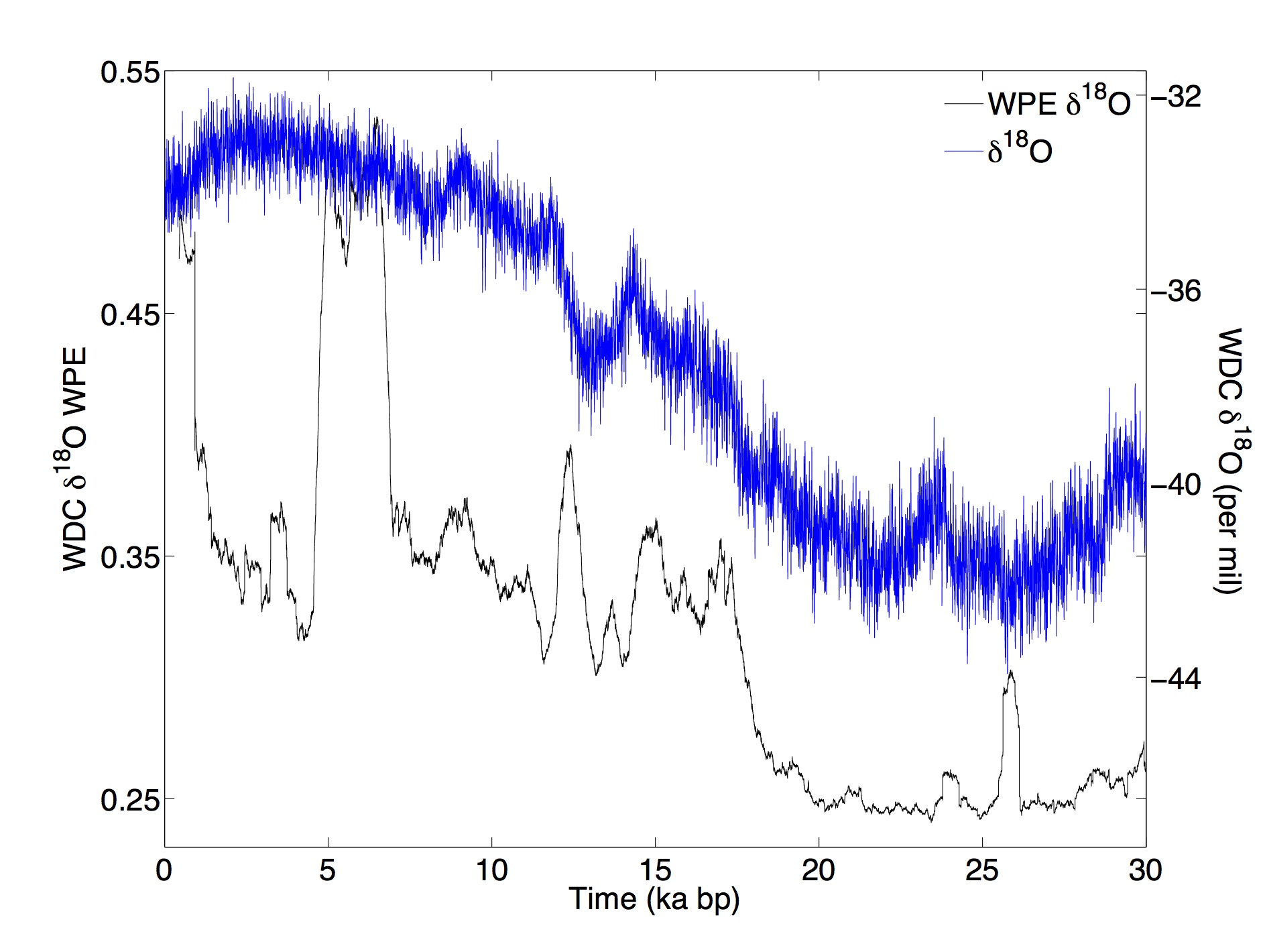Information-theoretic analysis of ice-core data
 |
Project Description
We take an information-theoretic approach to analyzing 68,000 years of water isotope data from the WAIS Divide ice core, the longest, highest-resolution record yet recovered from Antarctica. The water isotopes are primarily a proxy for local temperature at the time of snow deposition, but also contain information about broader atmospheric circulation patterns. Using estimates of the Shannon entropy rate of the isotope measurements, we find that the rate of information production reveals differences in analytical techniques, even when those differences leave no visible traces in the raw data. The entropy calculations also allow us to identify a number of intervals in the data that may be of direct relevance to paleoclimate interpretation.
Here are a few of those results:
 |
 |
The blue traces in these images are the d18O measurements from the NGRIP (left) and WAIS Divide (right) cores; the black traces are estimates of the Shannon entropy rate calculated from those signals using a weighted variant of permutation entropy (WPE) technique described by Fadlallah et al.. WPE measures the average rate at which new information-unrelated to anything in the past-is produced by the system that generated the time series. If that rate is very low, the current observation contains a lot of information about the past and the signal is perfectly predictable. If that rate is very high, all of the information in the observation is completely new: i.e., the past tells you nothing about the future. The 2016 Intelligent Data Analysis Symposium paper and 2019 Chaos paper cited below describe these ideas and results in more depth. You can also check out this press release from the Santa Fe Institute for a higher-level overview of the project.
A very interesting feature in the right-hand curve above is the large jump in WPE between 5-8 ka. As it turns out, an older instrument was used to analyze the ice in this region. The WPE results suggest that that instrument introduced noise into the data: i.e., every measurement contains completely new information, unrelated to the previous ones. That noise is not easy to see in the d18O data itself without a laborious, fine-grained examination by a human expert, but the anomaly is easily flagged with a quick calculation of WPE. By going back and re-measuring this segment of the ice, we were able to confirm the conjecture that the jump in WPE was due to noise in the older instrument; please see the 2018 Entropy paper cited below for more details or this press release from the Santa Fe Institute for more details.
It also turns out that WPE tracks accumulation, which is a very useful result, as described in 2019 the CHAOS paper below.
We have recently discovered that permutation entropy techniques can also detect mixing effects in a data set - e.g., when successive measurements are not independent - and even estimate the scales on which this occurs. This can happen in the laboratory apparatus (e.g., if measurements are performed in a chamber or a pipe) or in the study system (e.g., diffusion in the ice sheet). We are also studying this effect in methane data from Mauna Loa and ocean sediment cores. See the Neuder et al. paper in the list below for more details.
People
- Joshua Garland, Applied Complexity Fellow at the Santa Fe Institute.
- Tyler Jones, research associate, INSTAAR.
- Mike Neuder, BS student, University of Colorado (now in the MS program at Harvard).
- Jim White, Professor of Geological Sciences.
- Liz Bradley, Professor of Computer Science.
Papers, press, talks
- M. Neuder, E. Bradley, E. Dlugokencky, J. W. C. White, and J. Garland, "Detection of Local Mixing in Time-Series Data Using Permutation Entropy," in revision, Physical Review E. Preprint available on arXiv.
- J. Garland, T. R. Jones, M. Neuder, J. W. C. White, and E. Bradley, "Climate entropy production recorded in a deep Antarctic ice core," CHAOS 29 101105 (2019). Preprint available on arXiv.
- Presentation at the 2019 SIAM GeoScience Meeting
- J. Garland, T. R. Jones, V. Morris, M. Neuder, J. W. C. White, E. Bradley, "Anomaly Detection in Paleoclimate Records using Information Theory," Entropy 20:931 (2018)
- J. Garland and E. Bradley, "Information Theory in Earth and Space Science," SIAM News, October 2018
- J. Garland, T. Jones, E. Bradley, R. James and J. W. C. White, "A First Step Toward Quantifying the Climate's Information Production Over the Last 68,000 Years," IDA-16 (Proceedings of the 12th International Symposium on Intelligent Data Analysis), Stockholm, October 2016.
- Poster presentation at the 2016 AGU Fall Meeting
- Press releases from the Santa Fe Institute about the overall project and the anomaly detection specifics.
Support
- This material is based upon work supported by the National Science Foundation under grant number 1807478, among others. Any opinions, findings, and conclusions or recommendations expressed in this material are those of the author(s) and do not necessarily reflect the views of the National Science Foundation.
![]()